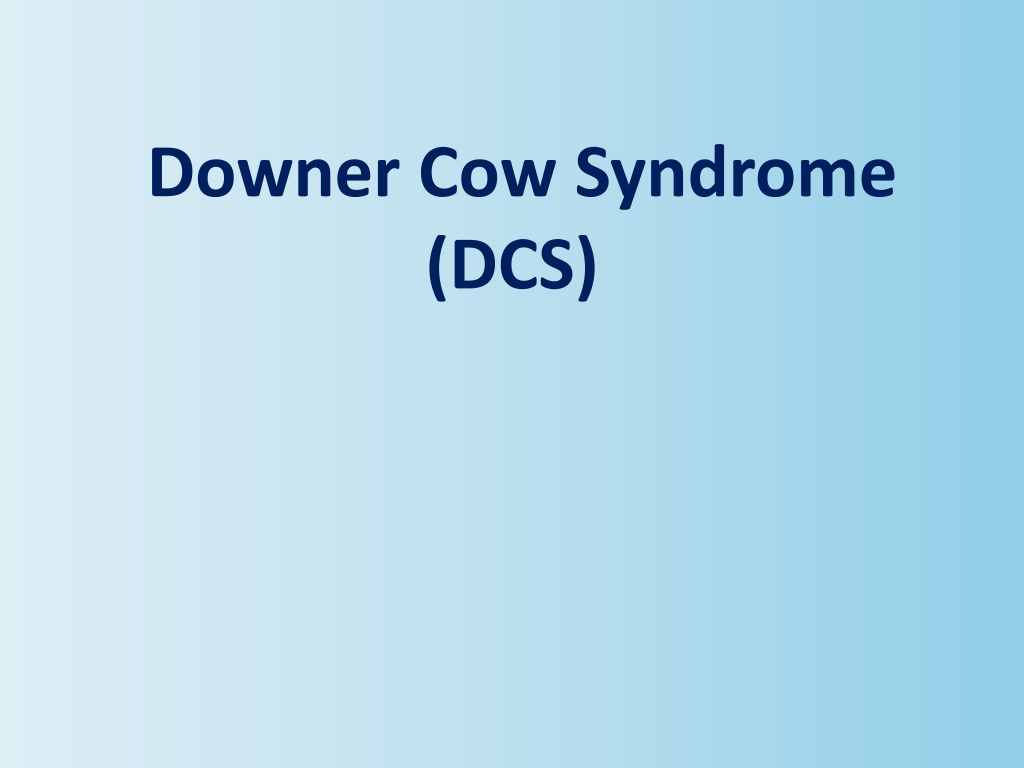Understanding Downer Cow Syndrome (DCS) in Cattle
Downer Cow Syndrome (DCS) is characterized by the inability of cows to rise, commonly seen around calving. It is associated with metabolic disorders, physical injuries, and prolonged recumbency. Risk factors include poor housing conditions and health issues like mastitis. Clinical signs range from dullness to hyperexcitability. Clinical pathology reveals hypocalcemia, muscle damage, and proteinuria. Necropsy findings may include muscle degeneration. Early recognition and appropriate management are crucial in addressing DCS in cattle.
Download Presentation

Please find below an Image/Link to download the presentation.
The content on the website is provided AS IS for your information and personal use only. It may not be sold, licensed, or shared on other websites without obtaining consent from the author. Download presentation by click this link. If you encounter any issues during the download, it is possible that the publisher has removed the file from their server.
E N D
Presentation Transcript
Downer Cow Syndrome (DCS)
The common clinical sign :The inability to rise They do not respond to treatment for hypocalcemia It can be seen at all stages of the production cycles Most are affected between 2 days before and 10 days after parturation They are high producers They suffer from parturient paresis i.e. partially paralyzed during labor
Etiology and pathogenesis A sequela to parturient paresis : 1. Metabolic disorders 2. Physical injuries during parturition 3. Traumatic muscular injuries associated with attempts to rise from prolonged recumbency contribute to the Downer condition
The risk factors associated with the development of DCS Parturient paresis As a result of delayed or incomplete treatment for hypocalcemia It may lead to ischemic muscle necrosis and nerve paralysis when the cow may be lying on one hind limb for 6-12 hrs. 1. 2. Hard and slippery floors predispose them to traumatic bone, ligament, joint, tendon, muscle and nerve injuries when they attempt to stand Poor housing conditions 3. Lead to traumatic nerve injury at parturition and muscle degeneration during prolonged recumbency More susceptible to incidences of Downer cow in herds Excess fat 4. Mastitis, metritis, and traumatic pericarditis Septic conditions 5. During periods of prolonged starvation, malnutrition contributes to the development of the DCS Malnutrition
Clinical signs: Cows may appear Bright and or alert Dull and depressed Hyper excited After treatment for hypocalcemia The cows usually appear alert and normal in most respects but are weak in the limbs or make no effort to rise
Clinical pathology 1. Cows have hypocalcemia (< 8mg Ca/ 100 ml) and hypophosphatemia (< 3mg P / 100ml) Serum Mg conc. may be low (< 1.5mg /100ml) showing muscle tremors or excitability 2. Serum aspartate transaminase (AST) and creatine phosphokinase (CPK) are elevated indicating muscle damage 3. Urinalysis: Animal shows proteinuria 2-3 days after extensive muscle damage Myoglobinuria: Should be differentiated from haemoglobinuria Ketonuria Bilirubinuria May also be present in complicated cases
Necropsy: No specific lesions Hemorrhage and degeneration of the upper hind limb musculature and nerves Myocarditis in some cases
Diagnosis: 1. Clinical signs is the basis of diagnosis 2. Clinical exam for differential diagnosis by paying special attention to the caudal part of the spine, including the tail, the pelvic ring and the hind legs. Rectal examination should be done 3. Painful reaction to manipulation, abnormal mobility, lack of motor and sensory responses, or audible crepitation may reveal the site and nature of physical injuries responsible recumbency for prolonged 4. AST > 200mU /ml indicates guarded prognosis, >500mU /ml indicates hopeless prognosis; increased CPK 5. Hypoglycemia, proteinuria, ketosis
Differential Diagnosis: Some conditions causing prolonged recumbency are bone fracture of pelvis, luxation of hip joints, and rupture of major muscles
Treatment: 1. Basic aim to get the cow onto her feet i.e. Hoisting a cow with hip clamps 2. Cow that show relapses after treatment with calcium alone are intravenously or solution containing Ca, P, Mg, glucose and K given more calcium 3. Phosphorus (30 gm sodium acid phosphate in 300 ml water intravenously) or Tonophosphan is given as downer hypophosphatemia cow show persistent 4. CNS stimulants e.g. tripelennamine HCl @ 0.5 mg/kg body weight by slow intravenous injection
5. Serum potassium and skeletal muscle potassium conc. are found to be low in downer cows. 10 liters of water containing 80gm NaCl and 20gm KCl are given by stomach tube and a similar solution is provided in a bucket for the cows to drink. Another container with fresh water is provided 6. Treatment of septic conditions like mastitis and metritis with broad-spectrum antibiotics 7. Provision of shelter, bedding and food to cows without obvious bone fractures and joint dislocations 8. Cows should be turned frequently (every 4-6 hr) from one side to other side
Preventions: Attention to nutrition to avoid excessively fat cows Low calcium intake in the preparturient period Early treatment of PP with sufficient calcium. At least 8 gm calcium is required for complete cure. Close observation should be made after treatment for relapses Provision of adequate bedding for cows during parturition and supervision of cows to minimize prolonged dystocia to prevent traumatic nerve and muscular damage

























